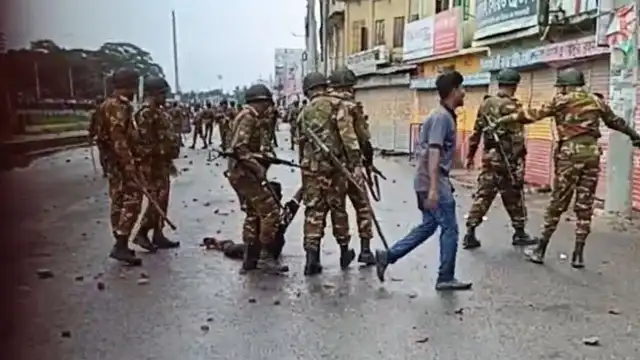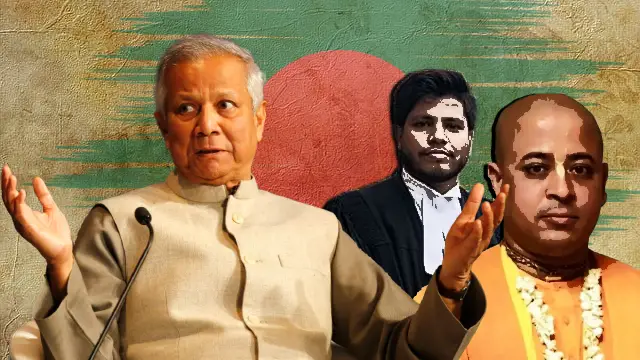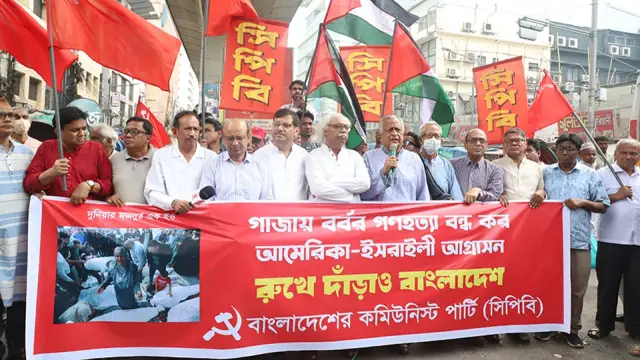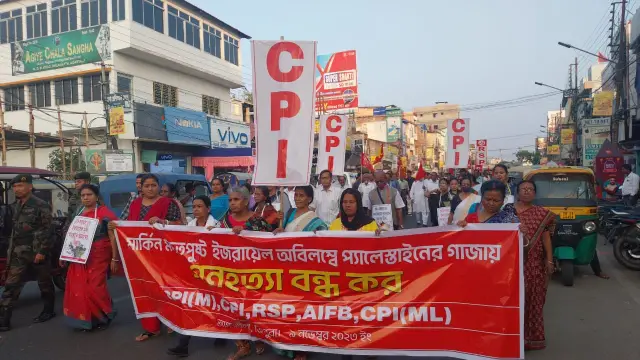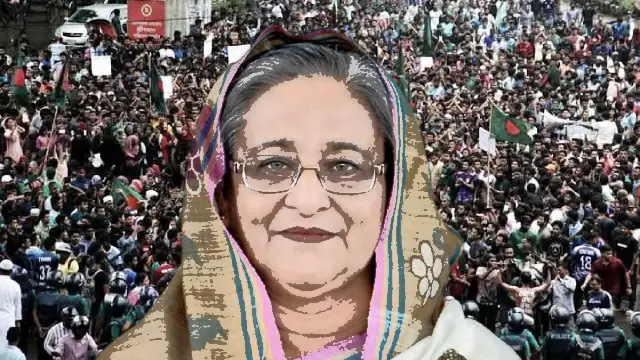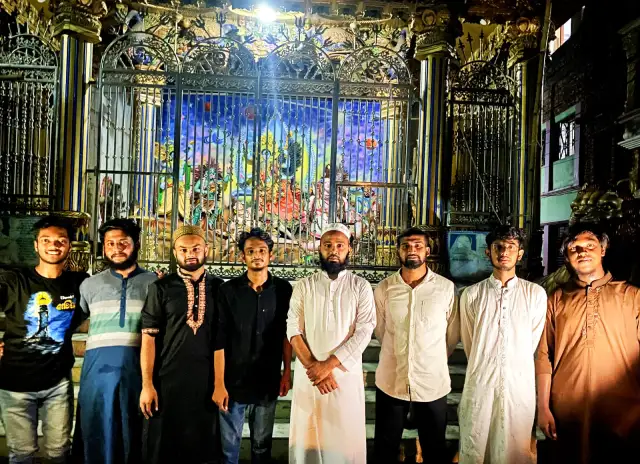The recent attack on National Citizen Party (NCP) activists who rallied to Bangladesh’s Gopalganj district, allegedly by the workers of the now deposed Awami League, and the counter-violence has occupied the headlines in Dhaka’s mainstream media but also caught global attention.
The NCP rally to Gopalganj on July 16th, celebrating the July uprisings of 2024, which led to the massacre of over a thousand students by the erstwhile Awami League government headed by Sheikh Hasina and later her downfall, faced attack from the former ruling party, which considers the district as its stronghold.
Five people were reportedly killed in the violence, prompting the NCP, Bangladesh’s only student-led political party established by several participants of the July uprisings, under former interim government advisor Nahid Islam, to carry out a nationwide protest movement.
This attack exemplifies a few disturbing trends in Bangladeshi politics, which hint at prolonging the instability that the South Asian country has been experiencing for nearly a year now.
Awami League threatens post-Hasina Bangladesh
The attack on NCP activists in Gopalganj district by Awami League activists shows that the deposed party, devoid of state power, continues to hold ground in various parts of the country.
This attack on NCP workers in Gopalganj district, Awami League’s stronghold, comes after the interim government imposed a ban on the former ruling party and its affiliate organisations until the trial against its leaders and workers for perpetrating atrocities during the July-August uprisings in 2024 is over.
The ban took place nine months after Ms Hasina, fearing a public backlash and the military’s siding with the popular unrest, took refuge in India.
Though the Awami League workers carried out agitations against the July Revolution, they suffered attacks from the interim government and their opponents during these nine months.
The ban was considered a last nail in the coffin of the Awami League, which ruled the South Asian country as an alleged Indian protege for over 15 years by suppressing the opposition.
Still, as the Awami League manages to maintain its political and organisational clout in the Gopalganj district, which also houses the party’s founder and Bangladesh’s first president, Sheikh Mujibur Rahman’s tomb in Tungipara, it shows that the threat posed by the party is far from over.
While its scelorotic rule for 15 years under Ms Hasina, Mr Rahman’s daughter, has left it with very few supporters, the critics allege the Awami League manages to remain strong in Gopalganj and other pockets with Indian support.
However, blaming the Awami League’s existence simply on India’s clandestine support appears to be an oversimplification of the issue.
The Awami League’s existence is a matter of the party’s ability to build strong networks using its hegemonic grip over Bangladesh’s resources during the last 15 years of its rule.
Ms Hasina’s government sustained itself on a network of loyal sycophants, up to the village level, sharing the booty of immense corruption in all government bodies.
While the interim government had promised to take action against Ms Hasina’s misrule, the evolving geopolitical scenario and its overall weaknesses prevented it from probing all crimes of the regime and from taking punitive actions.
So far, in the last 11 months, the government has merely overseen mob violence targeting the murals of Mr Rahman or memorials associated with the Awami League.
Most of these attacks were allegedly carried out by the far-right Islamists who have immense clout within the interim government led by Mohammad Yunus, due to their ties with the West, the Gulf monarchies and Türkiye.
However, except for arresting a few top leaders and some activists of the former ruling party for their role in the atrocities in the July-August uprisings, and except for condemning Ms Hasina’s provocative speeches from India, Dhaka has not taken measures against the party that it and its supporters label as “fascist”.
Most of the officials, who were allegedly aiding Ms Hasina’s autocracy, continue to hold their high offices.
While many have been forced to resign, the pro-Awami League bureaucracy and judiciary still exist and provide the much-needed oxygen to the Awami League’s underground network.
There is an overall fear, Bangladeshi experts underscore, among this section of top officials that if the Awami League-related proto-state is dismantled totally, they will not only lose their clout but may face prosecution for their role in aiding the crimes of the erstwhile regime.
Mr Yunus’s government’s inability to act promptly and investigate all crimes, including all crimes against humanity and financial scams, that took place under Ms Hasina’s rule has aided the Awami League to operate with impunity.
Speaking to the East Post on the condition of anonymity, one of the central leaders of the NCP claimed that the government’s reluctance to publish the July Charter has empowered the Awami League and paved the way for its future reinstatement in national politics, despite its role in the 2024 massacres.
The leader alleged that the interim government, which he called a blend of different shades of political ideologies, remain indecisive as it lacks confidence in taking major steps due to its unelected status.
On the one hand, the former microfinance entrepreneur and Nobel Laureate faces geopolitical challenges with the return of Donald Trump, who considers Mr Yunus a political foe, to the White House; on the other, Dhaka can’t antagonise New Delhi any further due to its dependencies on Indian infrastructure for various economic activities, including farming.
In case the interim government takes harsh steps against Ms Hasina’s ousted party, it will help India to project the interim government as one that’s carrying out vengeance.
India’s Prime Minister Narendra Modi and his far-right Hindutva-driven Bharatiya Janata Party (BJP), which rules India’s federal government and the majority of States, have already projected Mr Yunus’s government as one that has made Bangladesh’s minority Hindus unsafe.
For Mr Modi and the BJP, amplifying the narrative of a purported state-sponsored persecution of Hindus in Bangladesh not only aids the Hindutva camp’s agenda of polarising India’s majority Hindus against minority Muslims but also unites diverse forces worldwide, from Russia to the US, behind its agenda of restoring Ms Hasina’s government.
During the US presidential polls in 2024, Mr Trump himself mentioned the so-called Hindu persecution issue during a meeting on the Hindu festival of Diwali, while Director of National Intelligence Tulsi Gabbard has been parroting the Hindutva talking points on Bangladesh’s Hindus, apparently due to her close ties with the BJP.
In this scenario, Mr Yunus’s government can only win the support of European countries, which are sceptical of Mr Trump, but that won’t help him in running a major campaign against the Awami League.
Moreover, as the interim government is under pressure from diverse camps, the communists on the left and the Bangladesh Nationalist Party (BNP) on the right, to hold elections, it can’t take steps that an elected government can.
This has ensured that the Awami League exists in its pockets and continues its active opposition in the post-Hasina political landscape, despite facing public wrath.
Rise of the far-right
The Islamist far-right has managed to assert itself with vigour in post-Hasina Bangladesh, sidelining the progressive forces, which had compromised with the Awami League during its 15-year rule.
By utilising the massive public sentiment against the Awami League’s misrule, the Islamist forces have been able to provoke mob violence against their political opponents, including those on the left.
So far, despite having a fairly good number of left-wing and progressive elements in its top rank, the NCP has remained mum on the rise of Islamist forces in Bangladesh and condoned their mob violence under the broad blanket of “anti-fascist” mass movements.
While in their narratives, the Islamist forces continue to cover up the erstwhile regime’s links with the West, its implementation of neo-liberal policies, and only highlight Ms Hasina’s servility towards India as a smokescreen.
This has helped the Islamist far-right to equate Awami League’s rule with alleged Indian proxy rule and expansionism, while concealing that Bangladesh’s economy became highly reliant on exports to the West, especially the US, and remittances from the Middle East.
The inability of the left in Bangladesh to independently mobilise the masses or take a leading role in anti-Hasina movements during the 15-year-long Awami League rule isolated it in the national political landscape as a “pro-Hasina” bloc.
The Islamists have used this opportunity to captivate the core working class vote bank of the left, while at the same time they have initiated a series of mob violence in the country, labelling their opponents as “Awami League fascists”.
As Mr Yunus’s government exhibited its weakness in combating the Islamist mob violence, the Awami League used the loopholes to launch attacks on its opponents, the NCP, in its stronghold like Gopalganj. The Awami League has more such strongholds, including Khulna and Bagherhat, bordering Gopalganj.
With the far-right perpetrating violence on its opponents, and Mr Yunus’s government restricting itself to issuing condemnations but condoning the mob culture on the surface, the Awami League is able to justify its existence despite the ban and bamboozle those on the left and the progressive camps by showcasing the anarchy that has been created due to Ms Hasina’s ouster.
Meanwhile, India is also benefiting from the rise of this far-right mob violence in Bangladesh, especially those targeting its minority Hindus.
India benefits from Bangladesh’s anarchy
For India, Ms Hasina was an asset for years. Under her rule, India expanded its influence over Bangladesh and seized control of the country’s key institutions, critics allege.
Indian corporates enjoyed unregulated access to Bangladesh’s market and brought most of its key sectors under their control, including power, technology and finance.
However, since the ouster of Ms Hasina, the popular anti-India sentiments have spiked as Mr Modi’s government and the ruling BJP-affiliated Hindutva camp continued to peddle misinformation targeting Bangladesh, especially regarding the persecution of Hindus, which has been vehemently denied by Dhaka.
Amid the rising anti-India sentiments, the growing proximity between Bangladesh and China, following Mr Yunus’s Beijing visit in March, caused major trouble for India.
Although Bangladesh has not taken any major anti-India steps or curbed India’s business rights in the country, India has taken a series of punitive economic measures, including the denial of access to Indian land ports and sea ports, causing major upheaval in Bangladesh.
If Mr Yunus’s interim government manages to stabilise Bangladesh and bring the law and order situation in the country under control, it would be a loss for long-term Indian interests in the region.
If Bangladesh continues to reel under mob violence, if there are attacks on religious minorities, then it provides India with an opportunity to advocate its cause globally, while justifying Ms Hasina’s asylum despite a warrant against her.
A weaker Bangladesh, with an Islamist mob ravaging the country, will help the Islamophobic narrative used by Mr Modi’s BJP to provoke majority Hindus against minority Muslims in India.
Both the Awami League and the Islamists are working according to this playbook, ensuring the country remains polarised and the government faces immense challenges in providing a safe environment for foreign investment and business.
The attack on the NCP workers in Bangladesh’s Gopalganj by the Awami League workers proved that the situation continues to worsen and there can be no developments until a new government is formed following a general election.
Inside the attack on NCP in Bangladesh’s Gopalganj by Awami League
The attack on the NCP activists in Bangladesh’s Gopalganj district, allegedly by Awami League activists, has special significance.
While most of the political parties in Bangladesh have their rivalries, they were built at different times for different reasons.
The Islamist Jamat-e-Islami was founded in British India under the pan-Muslim identity movement started by Abul A’la al-Maududi.
Similarly, the Communist Party of Bangladesh was a splinter of the Communist Party of India, which was an ally of the Awami League during Bangladesh’s Liberation War.
The Awami League itself evolved from the Muslim League that founded Pakistan under Mohammad Ali Jinnah.
The BNP was founded by the chieftain of Bangladesh’s Liberation War, General Ziaur Rahman.
However, the NCP was founded in February 2025 by the students and youths who participated in the July-August uprisings to push forward the July Charter.
This is a party which calls itself free from dynastic rule, unlike the Awami League or the BNP, and promotes the demands of the youths and students. Its foundational values are linked to opposing the Awami League and its rule.
Unlike other parties, the NCP is a result of the uprisings, and one of its core policies is to oppose the Awami League.
This makes it a target for the Awami League, which sees the NCP as inseparable from the July-August uprisings in 2024.
For the Awami League, the idea of students and youths protesting its hegemony and trying to wrest control of its last stronghold became a major catalyst for the Gopalganj violence that followed.
The threat of the NCP expanding into its fortress, Gopalganj district, prompted the Awami League workers to launch the attack, which also created an optics of Bangladesh’s fractured law and order situation.
As the NCP lacks adequate organisational strength in the district, it suffered major setbacks and had to rely on the state’s institutions to save itself.
The attack on the NCP activists in Bangladesh’s Gopalganj district helped the Awami League to send a message to Dhaka that it continues to remain a crucial player in the post-Hasina political landscape despite the setbacks.
According to experts, the Awami League can still get around 20% to 25% votes if it’s allowed to participate in the general elections.
Using the attack on the NCP in Bangladesh’s Gopalganj, the Awami League reaffirmed its existence to revive the spirit of its demoralised workers, evading arrest.
Following the Gopalganj violence, the interim government also exhibited its weakness.
Mr Yunus’s office only limited itself to condemning the attack and supporting the police action that took place.
Yet, it failed to highlight how it’s going to tackle the culture of political violence, which looms over the republic even after its reincarnation following the 2024 uprisings.
Join our channels on Telegram and WhatsApp to receive geopolitical updates, videos and more.

